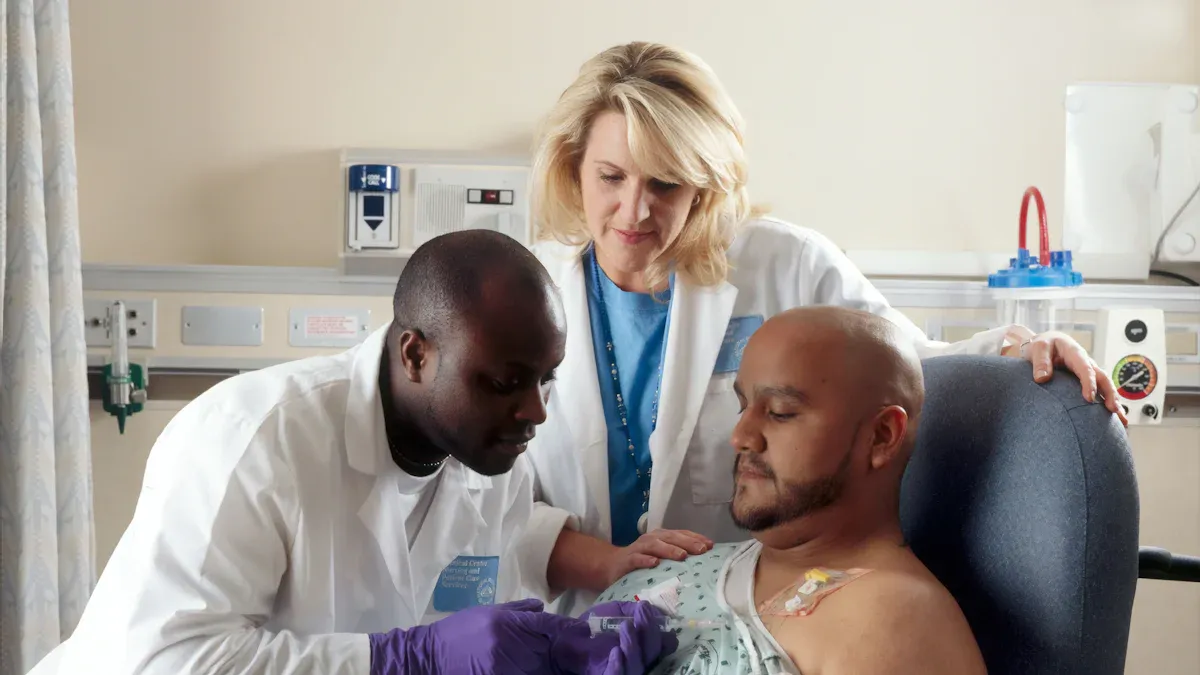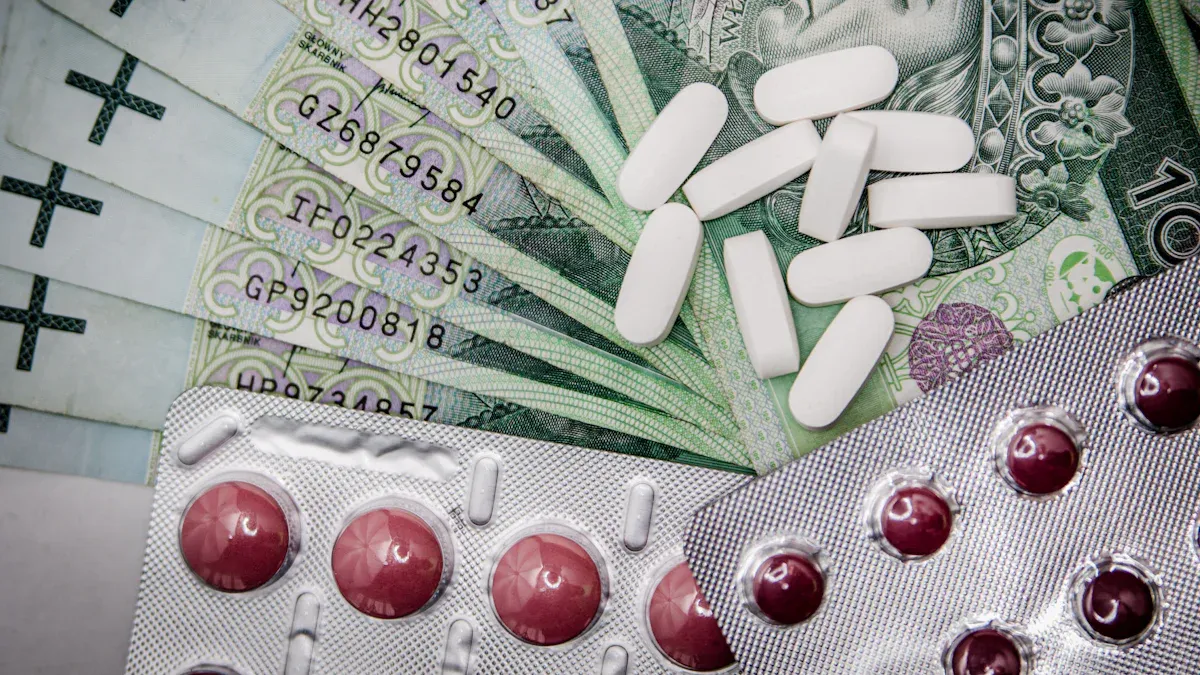The Economics of Cancer Care and Patient Impact

Cancer care costs have surged in recent years, creating significant challenges for patients like you. Treatments such as chemotherapy and biologics are among the most expensive, with nearly half of patients undergoing chemotherapy reporting financial strain. Advanced therapies and technologies, while life-saving, often come with high price tags. Studies show that cancer survivors with multiple chronic conditions face annual productivity losses exceeding $9,000. These rising expenses not only strain your finances but also impact your mental health and access to care. The Economics of Cancer Care: Balancing Cost and Access remains a critical issue for patients and policymakers alike.
Key Takeaways
Cancer treatment costs are going up, making it harder to afford. Knowing these costs can help you push for better care access.
Money problems from medical bills can hurt your mental health and recovery. Solving money issues early is important for staying healthy.
Look into charities and help programs to handle cancer costs. These groups can give you useful support.
Learn about your insurance and treatment choices. Knowing more helps you make smart choices and save money.
Speaking up for changes, like lowering drug prices, can cut costs and help everyone get the medicines they need.
The Economics of Cancer Care: Balancing Cost and Access

Advances in Treatment and Technology
Cutting-edge therapies and personalized medicine
Advancements in cancer treatment have revolutionized care. Personalized medicine, which tailors therapies to your genetic profile, offers better outcomes. However, these cutting-edge treatments often come with high costs. For example, the list price of new cancer therapies frequently exceeds $10,000 per month. This financial burden can make it difficult for you to access the most effective treatments, especially if insurance coverage is limited. Studies also show that 46% of patients consider treatment costs when deciding whether to pursue recommended care. These statistics highlight the challenge of balancing innovation with affordability.
High costs of medical equipment and diagnostic tools
Modern diagnostic tools, such as advanced imaging machines and robotic surgical systems, play a critical role in cancer care. These technologies improve accuracy and outcomes, but their high costs contribute to rising healthcare expenses. For instance, hospitals often pass the expense of acquiring and maintaining this equipment onto patients. This can lead to significant out-of-pocket costs, particularly for those without comprehensive insurance. The Economics of Cancer Care: Balancing Cost and Access becomes even more complex when these costs limit your ability to receive timely and accurate diagnoses.
Drug Development and Pricing
Lengthy and expensive drug development processes
Developing new cancer drugs is a lengthy and costly process. On average, it takes about 12 years and $3 billion to bring a drug from preclinical testing to market. Only 10-20% of drugs tested succeed, which drives up costs for the ones that do. These expenses are often passed on to you as a patient, making life-saving medications less affordable. The Economics of Cancer Care: Balancing Cost and Access becomes a pressing issue when these high development costs restrict access to essential treatments.
Monopoly pricing and lack of generic alternatives
Monopoly pricing in the pharmaceutical industry further inflates drug costs. Companies often patent new versions of drugs before older ones become available as generics, maintaining high prices. For example, three companies dominate the U.S. insulin market, leading to limited competition and unaffordable prices. Regulatory measures, such as capping launch prices, could help address this issue. Without such reforms, you may face significant financial barriers to accessing necessary medications.
Administrative and Healthcare System Costs
Complex billing systems and administrative overhead
The complexity of billing systems in cancer care adds to overall costs. Administrative tasks, such as processing insurance claims and managing patient records, require significant resources. These inefficiencies increase healthcare expenses, which are often passed on to you. A study found that 33% of insured adults aged 19 to 64 reported medical bill problems or debt, underscoring the financial strain caused by systemic inefficiencies.
Variability in healthcare pricing across providers
Healthcare pricing varies widely between providers, even for the same treatments. This inconsistency makes it challenging for you to predict costs and plan financially. For example, an analysis of MarketScan data revealed that patients with employer-provided insurance faced out-of-pocket expenses ranging from $7,000 to $11,000 over four years, despite total care costs reaching up to $280,000. Addressing these disparities is essential to ensure equitable access to cancer care.
Implications for Patients

Financial Burden and Medical Debt
Out-of-pocket expenses and insurance gaps
Cancer treatment often leads to significant out-of-pocket expenses. Many patients face gaps in insurance coverage, leaving them responsible for high costs. Studies show that 18% of long-term breast cancer survivors spent between $2,001 and $5,000 on out-of-pocket expenses, while 17% spent over $5,000. Recently diagnosed survivors aged 18 to 64 reported an average of $1,107 in annual out-of-pocket spending. These financial burdens can make it difficult for you to afford necessary care, especially if you lack comprehensive insurance.
Long-term financial consequences for families
Medical debt from cancer care can have lasting effects on your family’s financial stability. A survey revealed that 47% of cancer patients and survivors carry medical debt, with 49% owing over $5,000. Additionally, 69% of those in debt have carried it for more than a year. This financial strain often forces families to make difficult choices, such as skipping meals or delaying other essential expenses.
Key Findings | Statistics |
|---|---|
Percentage of cancer patients and survivors with medical debt | 47% |
Percentage carrying over $5,000 in medical debt | 49% |
Percentage with debt for more than a year | 69% |
Percentage who skipped or delayed care | 25% |
Emotional and Psychological Impact
Stress and anxiety related to financial strain
Financial stress can take a toll on your emotional well-being. Research shows that patients experiencing financial problems are more likely to report poor mental health. One study found that 30% of patients viewed financial distress as more severe than physical or emotional distress. This stress can also impact your treatment outcomes. According to Roswell Park Comprehensive Cancer Center, financial worry at the start of treatment doubles the risk of poor outcomes.
"If you are worried about your finances, your risk of dying is roughly double." – Roswell Park Comprehensive Cancer Center
Impact on mental health and quality of life
Financial distress often reduces your quality of life. Patients with high financial stress report lower satisfaction with social activities and relationships. This emotional burden can make it harder for you to focus on recovery and maintain a positive outlook during treatment.
Barriers to Accessing Care
Delayed or foregone treatment due to costs
High costs frequently lead to delayed or skipped treatments. Approximately 25% of patients report skipping or delaying care due to financial concerns. This can worsen your condition and reduce the effectiveness of treatment.

Disparities in access based on socioeconomic status
Socioeconomic factors play a significant role in your ability to access care. Black and Hispanic patients are more likely to be denied care due to medical debt, with rates of 14% and 13%, respectively. These disparities highlight the need for systemic reforms to ensure equitable access to cancer care. Addressing these issues is essential to balance cost and access, as outlined in The Economics of Cancer Care: Balancing Cost and Access.
Addressing the Issue
Policy and Systemic Changes
Advocating for drug price regulation
Regulating drug prices can significantly reduce the financial burden on you as a patient. Policies like Medicare drug price negotiations have shown promising results. For example, Medicare could save $14.4 billion on the top 50 dispensed oral drugs. Additionally, between 2012 and 2017, price increases on existing drugs in the U.S. amounted to $6.8 billion, while similar drugs globally saw $1.7 billion less in price increases. These statistics highlight the potential of policy reforms to make medications more affordable. Expanding such measures could ensure that life-saving treatments remain accessible to everyone.
Evidence Description | Statistical Outcome |
|---|---|
Medicare negotiation could save | $14.4 billion on top 50 dispensed oral drugs |
Price increases on existing drugs in the U.S. | $6.8 billion (2012-2017) |
Price decreases in similar drugs globally | $1.7 billion less (2012-2017) |
Streamlining healthcare administration to reduce costs
Administrative inefficiencies in healthcare drive up costs for you. Simplifying billing systems and reducing overhead can lower expenses. The American Cancer Society Cancer Action Network (ACS CAN) emphasizes the importance of systemic reforms like Medicaid expansion. Over 2.2 million individuals, many of whom are people of color, remain in a coverage gap. Expanding Medicaid in states that have not yet done so could improve access to cancer care and reduce costs. These changes would help create a more equitable healthcare system.
Key Benefits of Medicaid Expansion:
Improves access to care for over 2.2 million individuals.
Reduces disparities, especially for people of color.
Lowers overall healthcare costs through preventive care.
Patient Advocacy and Support Resources
Nonprofit organizations and financial assistance programs
Nonprofit organizations play a vital role in helping you manage the financial challenges of cancer care. Financial navigators, for instance, assist patients in avoiding adverse financial consequences after diagnosis. These programs address financial distress, which often leads to reduced therapy adherence, lower quality of life, and diminished survival rates. However, more comprehensive studies are needed to validate the effectiveness of these interventions fully. By connecting with these resources, you can find support to ease the economic strain of treatment.
Intervention Type | Description |
|---|---|
Financial Navigators | Help cancer patients avoid adverse financial consequences after diagnosis. |
Financial Distress Impact | Evidence shows that financial distress leads to reduced therapy adherence, lower quality of life, and diminished survival. |
Need for Further Studies | Highlights the necessity for more comprehensive studies to validate the effectiveness of financial assistance interventions. |
Importance of patient education and empowerment
Educating yourself about available resources and treatment options can empower you to make informed decisions. Many organizations provide tools to help you understand insurance policies, treatment costs, and financial aid programs. This knowledge can reduce stress and improve your ability to navigate the healthcare system. Empowerment through education ensures that you can advocate for your needs and access the care you deserve. The Economics of Cancer Care: Balancing Cost and Access underscores the importance of these efforts in addressing systemic challenges.
Rising cancer care costs stem from advancements in treatment, high drug prices, and systemic inefficiencies. These expenses create significant challenges for you, affecting your finances, mental health, and access to care. Studies show that financial distress inversely correlates with quality of life, with patients reporting poorer physical and mental health outcomes.
Outcome | Financial Burden | No Financial Burden |
|---|---|---|
Physical Component Score | -2.45 | N/A |
Mental Component Score | -3.05 | N/A |
Likelihood of Depressed Mood | OR: 1.95 | N/A |
Likelihood of Recurrence Worries | OR: 3.54 | N/A |
Addressing these challenges requires systemic reforms, such as eliminating copayments, and expanding patient support resources. These changes can reduce financial toxicity and improve your overall well-being.
FAQ
What are the main factors driving the high cost of cancer care?
Several factors contribute to rising cancer care costs. These include expensive drug development, advanced medical technologies, and administrative inefficiencies. Hospitals and pharmaceutical companies often pass these costs on to you, making treatment less affordable.
💡 Tip: Understanding these factors can help you advocate for cost-saving measures and explore financial assistance options.
How can you reduce out-of-pocket expenses for cancer treatment?
You can reduce costs by exploring nonprofit financial aid programs, negotiating payment plans with providers, and reviewing your insurance policy for coverage gaps. Many organizations offer resources to help you manage expenses effectively.
Note: Always ask your healthcare provider about generic drug options or alternative treatments to lower costs.
Why do drug prices remain so high despite advancements in healthcare?
Drug prices stay high due to lengthy development processes, patent protections, and limited competition. Pharmaceutical companies often set monopoly prices, which restrict access to affordable medications.
Reason | Impact on You |
|---|---|
Patents | Limits generic alternatives |
Monopoly pricing | Increases medication costs |
High R&D expenses | Passed on to patients |
What resources are available to help you manage financial stress during treatment?
Nonprofit organizations, financial navigators, and patient advocacy groups provide support. They can guide you through insurance claims, payment plans, and financial aid applications.
Example: Groups like the American Cancer Society offer free resources to help you navigate the financial challenges of cancer care.
How does financial stress affect your cancer treatment outcomes?
Financial stress can worsen your mental health and reduce treatment adherence. Studies show that patients with financial worries face higher risks of poor outcomes. Addressing financial concerns early can improve your overall well-being and recovery.
Reminder: Speak with a financial counselor or social worker to address financial toxicity and focus on your health.
See Also
Recognizing Symptoms And Treatments For Duodenal Cancer
Symptoms And Treatment Options For Conjunctival Melanoma
Exploring Cancer Types Associated With AIDS Infection
Essential Information About Embryonal Carcinoma You Should Know
